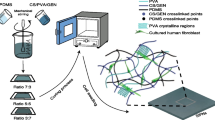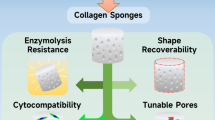Abstract
Polyanionic collagen obtained from bovine pericardial tissue submitted to alkaline hydrolysis is an acellular matrix with strong potential in tissue engineering. However, increasing the carboxyl content reduces fibril formation and thermal stability compared to the native tissues. In the present work, we propose a chemical protocol based on the association of alkaline hydrolysis with 1,4-dioxane treatment to either attenuate or revert the drastic structural modifications promoted by alkaline treatments. For the characterization of the polyanionic membranes treated with 1,4-dioxane, we found that (1) scanning electron microscopy (SEM) shows a stronger reorientation and aggregation of collagen microfibrils; (2) histological evaluation reveals recovering of the alignment of collagen fibers and reassociation with elastic fibers; (3) differential scanning calorimetry (DSC) shows an increase in thermal stability; and (4) in biocompatibility assays there is a normal attachment, morphology and proliferation associated with high survival of the mouse fibroblast cell line NIH3T3 in reconstituted membranes, which behave as native membranes. Our conclusions reinforce the ability of 1,4-dioxane to enhance the properties of negatively charged polyanionic collagen associated with its potential use as biomaterials for grafting, cationic drug- or cell-delivery systems and for the coating of cardiovascular devices.







Similar content being viewed by others
References
Hubbell JA. Biomaterials in tissue engineering. Nat Biotechnol. 1995;13:565–76.
Deuel TF. On principles of tissue engineering. London: Academic Press; 1997.
Adam B, Alain R, Adrien C. Vascular endothelial cell responses to different electrically charged poly(vinylidene fluoride) supports under static and oscillating flow conditions. Biomaterials. 1997;18:107–12.
Kouvroukoglou S, Dee KC, Bizios R, McIntire LV, Zygourakis K. Endothelial cell migration on surfaces modified with immobilized adhesive peptides. Biomaterials. 2000;21:1725–33.
Ramachandran GN. On treatise on collagen. New York: Academic Press; 1967.
Lee CH, Singla A, Lee Y. Biomedical applications of collagen. Int J Pharm. 2001;221:1–22.
Hayashi T, Nagay Y. Factors affecting the interactions of collagen molecules as observed by in vitro fibril formation. J Biochem. 1972;72:749–58.
Albee FH. Studies in bone growth: triple calcium phosphate as a stimulus to osteogenesis. Ann Surg. 1920;71:32–6.
Alberius P. Role of osteopromotion in experimental bone grafting to the skull: a study in adult rats using a membrane technique. J Oral Maxillofac Surg. 1992;50:829–34.
Plepis AMG, Goissis G, Das-Gupta DK. Dieletric and pyroelectric characterization of anionic and native collagen. Pol Eng Sci. 1996;36:2932–8.
Goissis G, Plepis AMG, Rocha JL. A process for the extraction of collagen from tissues with aqueous organic solvent in alkaline media. Brazilian patent BRPI:9.405.043-0, Dec 1994.
Bet MR, Goissis G, Lacerda CA. Characterization of polyanionic collagen prepared by selective hydrolysis of asparagines and glutamine carboxyamide side chains. Biomacromolecules. 2001;2:1074–9.
Goissis G, Piccirili L, Goes JC, Plepis AMG, Das-Gupta DK. Anionic collagen: polymer composites with improved dielectric and rheological properties. Artif Organs. 1998;22:203–9.
Goissis G, Suzigan S, Parreira DL. A study on the integration of acellular polyanionic collagen:elastin matrices by soft tissue. Artif Organs. 2001;25:822–9.
Bet MR, Goissis G, Vargas S, Salistre-de-Araujo HS. Cell adhesion and cytotoxicity studies over polyanionic collagen surfaces with variable negative charge and wettability. Biomaterials. 2003;24:131–7.
Rosa FP, Lia RCC, Souza KOF, Goissis G, Marcantonio JE. Tissue response to polyanionic collagen:elastin matrices implanted in rat calvaria. Biomaterials. 2003;24:207–12.
Na GC. Interaction of calf skin collagen with glycerol: linked function analysis. Biochemistry. 1986;25:967–73.
Park KD, Lee WK, Yun JY, Han DK, Kim SH, Kim YH, Kim HM, Kim KT. Novel anticalcification treatment of biological tissues by grafting of sulphonated poly(ethylene oxide). Biomaterials. 1997;18:47–51.
Gratzer PF, Pereira CA, Lee JM. Solvent environment modulates effects of glutaraldehyde crosslinking on tissue-derived biomaterials. J Biomed Mater Res. 1996;31:533–43.
Forti FL, Goissis G, Plepis AMG. Modifications on collagen structures promoted by 1,4-dioxane improve thermal and biological properties of bovine pericardium as a biomaterial. J Biomater Appl. 2006;20:267–85.
Goissis G, Suzigan S, Diderot PR, Maniglia JV, Braile DM, Raymundo S. Preparation and characterization of collagen:elastin matrices from blood vessels intended as small diameter vascular grafts. Artif Organs. 2000;24:217–23.
Vaissiere G, Chevallay B, Herbage D, Damour O. Comparative analysis of different collagen-based biomaterials as scaffolds for long-term culture of human fibroblasts. Med Biol Eng Comput. 2000;38:205–10.
Forti FL, Bet MR, Goissis G. Study of structure and cytotoxicity of anionic and native collagen from bovine pericardium. Acta Microsc. 1999;8:15–6.
Frish SM, Ruoslahti E. Integrins and anoikis. Curr Opin Cell Biol. 1997;9:701–6.
Hunt JA, McLaughin PJ, Flanagan BF. Techniques to investigate cellular and molecular interactions in the host response to implanted biomaterials. Biomaterials. 1997;22:1449–59.
Khor E, Wee A, Tan BL, Chew TY. Methods for the treatment of collagenous tissues for bioprostheses. Biomaterials. 1997;18:95–105.
Rizvi R, Kim JK, Naguib H. The effect of processing and composition on the properties of polylactide–multiwall carbon nanotube composites prepared by solvent casting. Smart Mater Struct. 2010;19(9):4003–10.
Rocha LB, Goissis G, Rossi MA. Biocompatibility of anionic collagen matrix as scaffold for bone healing. Biomaterials. 2002;23:449–56.
De Paula M, Goissis G, Martins VC. Rheological behavior of anionic collagen injectable gels in the presence of rhamsan for plastic surgery applications. J Mater Sci Mater Med. 2007;18:1683–90.
Schoen FJ, Tsao JW, Levy RJ. Calcification of bovine pericardium used in cardiac valve bioprostheses. Am J Pathol. 1986;123:134–45.
Wiesmann HP, Hartig M, Stratmannb U, Meyer U, Joos U. Electrical stimulation influences mineral formation of osteoblast-like cells in vitro. Biochim Biophys Acta. 2001;1538:28–37.
Acknowledgments
This work was supported by grants from FAPESP (Fundação de Amparo a Pesquisa do Estado de São Paulo) and CNPq (Conselho Nacional de Desenvolvimento Científico e Tecnológico). The authors thank E. Biazin and G. D. Broch for technical assistance and Prof. Dr. Hugo A. Armelin, from IQ-USP, for the cellular biocompatibility assays performed in his laboratory. We also thank Prof. Dr. Shaker Chuck Farah, Prof. Dr. Mauricio da Silva Baptista and Prof. Dr. Deborah Schechtman for critically reading the manuscript and offering welcome suggestions.
Author information
Authors and Affiliations
Corresponding author
Rights and permissions
About this article
Cite this article
Forti, F.L., Bet, M.R., Goissis, G. et al. 1,4-Dioxane enhances properties and biocompatibility of polyanionic collagen for tissue engineering applications. J Mater Sci: Mater Med 22, 1901–1912 (2011). https://doi.org/10.1007/s10856-011-4358-8
Received:
Accepted:
Published:
Issue Date:
DOI: https://doi.org/10.1007/s10856-011-4358-8




